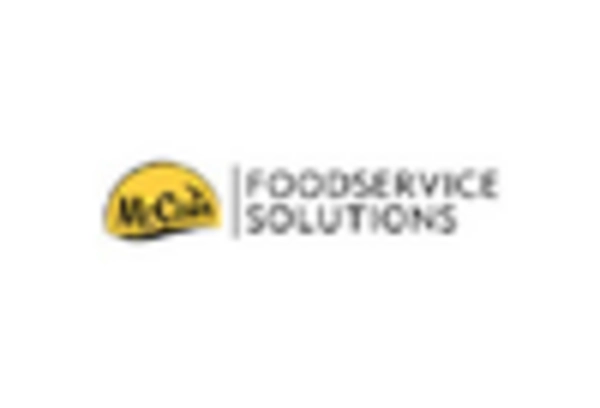The Frozen Fruit and Vegetables Mix Market is currently characterized by a dynamic competitive landscape, driven by increasing consumer demand for convenient, healthy food options. Key players are actively engaging in various strategies to enhance their market positioning. For instance, Dole Food Company (US) emphasizes innovation in product offerings, focusing on organic and non-GMO options to cater to health-conscious consumers. Similarly, Greenyard (BE) is pursuing regional expansion, particularly in emerging markets, to capitalize on the growing demand for frozen produce. These strategies, alongside others from major players like McCain Foods (CA), which is investing in digital transformation to streamline operations, collectively shape a competitive environment that is increasingly focused on sustainability and consumer preferences.
In terms of business tactics, companies are localizing manufacturing to reduce supply chain vulnerabilities and optimize logistics. The market structure appears moderately fragmented, with several key players holding substantial market shares while also facing competition from smaller, niche brands. This fragmentation allows for diverse product offerings, yet the influence of major companies remains significant, as they set trends and standards within the industry.
In August 2025, Bonduelle (FR) announced a strategic partnership with a leading technology firm to enhance its supply chain transparency through blockchain technology. This move is likely to bolster consumer trust and improve operational efficiency, aligning with the growing demand for traceability in food sourcing. Such initiatives not only enhance Bonduelle's competitive edge but also reflect a broader industry trend towards integrating technology in supply chain management.
In September 2025, Del Monte Foods (US) launched a new line of frozen vegetable mixes that are specifically tailored for plant-based diets. This strategic introduction is indicative of the company's commitment to innovation and responsiveness to evolving consumer preferences. By tapping into the plant-based trend, Del Monte positions itself favorably in a market that increasingly values health and sustainability.
Furthermore, in July 2025, Pinnacle Foods (US) expanded its distribution network by entering into a collaboration with major retail chains to enhance product availability. This strategic move is crucial for increasing market penetration and ensuring that their frozen fruit and vegetable mixes reach a broader audience, thereby solidifying their market presence.
As of October 2025, the competitive trends within the Frozen Fruit and Vegetables Mix Market are increasingly defined by digitalization, sustainability, and the integration of artificial intelligence in operations. Strategic alliances are becoming more prevalent, as companies recognize the value of collaboration in enhancing innovation and operational efficiency. Looking ahead, it appears that competitive differentiation will likely evolve from traditional price-based competition to a focus on innovation, technological advancements, and the reliability of supply chains, reflecting a shift in consumer expectations and market dynamics.

















Leave a Comment